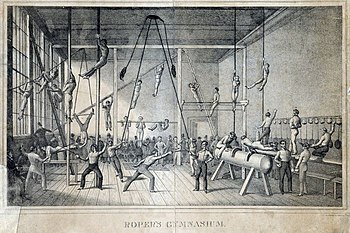Calisthenics
![]()
The articles Deadweight Exercise and Calisthenics overlap thematically. Information that you are looking for here can also be found in the other article.
You are welcome to participate in the relevant redundancy discussion or directly help to merge the articles or better distinguish them from each other (→ instructions).
![]()
This article or subsequent section is not sufficiently supported by evidence (e.g., anecdotal evidence). Information without sufficient evidence may be removed in the near future. Please help Wikipedia by researching the information and adding good supporting evidence.
Calisthenics (Greek: καλός, kalos "beautiful", "good" and σθένος, sthenos "strength") is an internationally used cultural term that integrates self-weight exercises. The hub of the scene are so-called calisthenics parks. These usually include bars of different heights and positions, which are modeled after parallel bars and high bar. Calisthenics includes the repertoire of classical apparatus gymnastics and various acrobatic exercises. External weights and accessories are rarely used.
Compared to classic strength training with isolated exercises, the focus is on intermuscular coordination. Thus, in exercises such as the "human flag", different muscle groups cooperate to maintain balance. The stability of the body improves.
,_2013.jpg)
Calisthenics exercise: The human flag
Training Methods
With the exception of weight vests, hardly any additional weights are used. The weight moved during the exercises is largely constant. In order to ensure a progressive additional load, in calisthenics one complicates the training by changing the lever arm, transitioning to more difficult exercises (e.g. from pull-ups to one-arm pull-ups), explosive exercise execution or supersets. Resistance bands can be used as an option.
Common exercises
- Push Ups - Push Ups
- Bar support - Dips
- Pull-up - Pull Ups
- Squat - Squats
Community Calisthenics
In bodyweight exercises with a partner, or partner exercises in general, two or more participants perform exercises together, using each other as "sport equipment", as it were. Examples:
- Squat, jump or hop, with shouldered partner
- Knee lift with someone on your knee
- Tug of War
- Crunches, legs wrapped around the waist of the standing partner
One disadvantage is that it is more difficult to determine the amount of force required compared to the use of free weights or machines. On the other hand, common equipment and gyms can be dispensed with and the training becomes spatially flexible.

A squat exercise requires little space and no equipment.
History
At the beginning of the 21st century, self-weight exercises used until then were modified and combined with elements from other sports. The starting point was New York. In the public sports parks there, people could train outside of gyms. The sports or workout parks often have a variety of pull-up bars, parallel bars, and dumbbells on which people train with their own body weight. Various groups developed their own style by combining classic calisthenics with exercises from gymnastics, breakdancing and freerunning and coming up with new movements. These groups posted videos of the new form of calisthenics on the Internet and triggered a new fashion, among others, especially in Eastern Europe.
In 2011, the first world championship for calisthenics or street workout took place in Riga. It was hosted by the WSWCF (World Street Workout and Calisthenics Federation). Since then, the world championship has been repeated annually. Among the most famous representatives of modern calisthenics are the groups Bartendaz, Baristi, Barstarzz, Bar-Barians and Street Workout Ukraine and individuals such as Hannibal for King and Frank Medrano.

Roper's Gym, Philadelphia, circa 1831
Questions and Answers
Q: What is calisthenics?
A: Calisthenics is a series of exercises used to develop strength, power and balance or a repeated rhythmical exercise that uses the weight of the body as resistance or the systematic exercises for attaining strength-gracefulness.
Q: Where does the word 'calisthenics' come from?
A: The name calisthenics is Greek in origin, a combination of the words 'beauty' and 'strength'.
Q: What are calisthenic exercises designed to do?
A: Calisthenics are designed to promote general physical fitness and overall good health.
Q: Is it necessary to use weights when doing calisthenic exercises?
A: No, calisthenic exercises can be done using only your own bodyweight as resistance.
Q: Are there any benefits associated with doing calisthenic exercises?
A: Yes, some potential benefits include improved muscle tone, increased flexibility and coordination, improved cardiovascular health, increased strength and endurance.
Q: Who should consider doing calisthenic exercises?
A: Anyone looking to improve their overall physical fitness should consider incorporating calisthenic exercises into their workout routine.
Q: How often should you do calisthenic workouts?
A: It depends on individual goals but generally speaking it's recommended to do them at least 2-3 times per week for best results.
Search within the encyclopedia